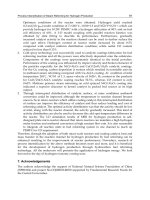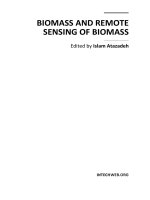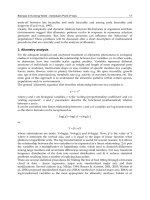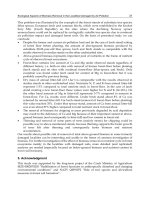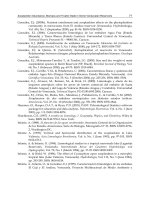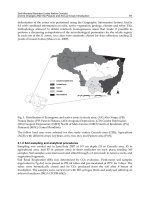Evapotranspiration Remote Sensing and Modeling Part 18 pptx
Bạn đang xem bản rút gọn của tài liệu. Xem và tải ngay bản đầy đủ của tài liệu tại đây (276.71 KB, 16 trang )
Adaptability of Woody Plants in Aridic Conditions
499
Fig. 5. Wild pear (Pyrus pyraster) and service tree (Sorbus domestica) stand classification in
Slovakia according to climate-geographic types.
of two of the analysed locations (1 and 5), where the annual average temperature ranges
from 7.5°C to 7.7°C. The average annual sum of precipitation for the majority of the stands is
610–700 mm, with the exception of the two mentioned locations, where this parameter
reaches 790 mm and 750 mm, respectively. The potential evapotranspiration amount in the
majority of the analysed stands was 600–750 mm during one year. Considering that the
annual average sum of precipitation is 610–700 mm, it is possible that the service tree has to
obtain enough moisture during the main growing season predominantly from water
resources in soil. The deficit of rain during the summer occurs in the majority of the stands
with this woody plant.
Warm and arid (southeast, south, southwest, and even west) stand exposures play an
important role in the formation of the arid microclimate and mezzo-climate of the
mentioned locations. According to climate classification in Slovakia (Špánik et al., 1999), the
analysed locations with service trees were in warm and even moderately warm as well as
semi-humid and even semi-arid climates. Compared to the wild pear, the service tree
prefers stands at lower altitudes and is prevalent in warm and arid climates. The wild pear
has wider ecological amplitude and grows at higher altitudes in stands with different water
regimes and climate extremes.
Based on the brief pedology characteristics of our experimental plots, we can hypothesize
that these soils are very well fertile (Chernozem, Fluvi-mollic soils, Cambisols, and Orthic
Luvisols) or well supplied with nutrients (Luvisols, Pararendzinas, and Fluvisols). In
addition, browned Rendzinas can be considered as relatively favourable soils.
According to the ecological scheme of Ellenberg (1978), the wild pear is a woody plant
with broad ecological amplitude that grows in nearly all soil types, with the exception of
extreme acidic soils. Rittershoffer (1998) found that mildly acidic or mildly alkaline soils
were optimal for wild pear growth. According to information from Westfalen-Lippe
(Germany), the wild pear prefers soils developed on limestone or on the rich nutrient
0
10
20
30
40
50
60
plane climate fold climate mountain climate
(%)
Pyrus pyraster Sorbus domestica
Evapotranspiration – Remote Sensing and Modeling
500
parent rocks (80% of stands) (Schmitt, 1998). In the area of Süd-Niedersachsen und
Nordhessen (Germany), the wild pear frequently grows in shallow rendzinas from mussel
limestone or from lime sandstone, and very rarely appears on deeper brown forest soils.
More than 92% of all natural stands were on rich basic rocks (Hofmann, 1993). In the
forest on the Plateau Lorraine, the wild pear grows mainly on parent rock of the mussel
limestone and on keuper sediments. There are deep terra fusca soils and shallow
Rendzinas (Wilhelm, 1998). The colective data from different areas of the natural
distribution indicate that suitable growth conditions for the wild pear are mainly basic
and rich nutrient soils with occasional water deficits.
In Slovakia, the wild pear grows on fertile soils (Chernozem, Fluvi-mollic soils, Cambisols,
and Orthic Luvisols), or soils well supplied with nutrients (Albic Luvisol, Pararendzina, and
Fluvisol). In addition, in some stands it grows on soils that are rich in minerals but under
conditions of unbalanced soil chemistry with little fertility (Paganová, 2003).
In general, Fluvi-mollic and Cambisol soils have a sufficient water supply. At lower
altitudes, the water deficit appears mainly in Rendzinas. The water deficit in Luvisols is
usually a result of a lower amount of precipitation and higher evaporation. Orthic Luvisols
have a lower water supply, and therefore the possibility of their aridization is higher. In
addition, a fluctuating water regime appears within the Planosols and Fluvisols (Šály, 1988).
According to the ecological scheme by Ellenberg (1978), the wild pear has optimal growth
conditions on fresh basic soils (its potential optimum). Another more frequent existence
optimum of this woody plant is near the xeric forest limit, where the wild pear grows in arid
soils rich in bases as well as in moderately acidic soils. Some authors have placed the wild
pear among xerophytic woody plants according to its lower demands on soil humidity
(Bouček, 1954). When under competition with some woody plants, it grows on its
synecological optimum in extreme arid stands - rocky hilltops, stands of the xeric forest
limit close to steppe communities, and in the sparse xerophytic oak woodlands
(Rittershoffer, 1998). However, another existence optimum of this woody plant occurs in
the hydric forest boundary in stands of the hardwood floodplain forests, where wild pear
growth is limited by inundation (Rittershoffer, 1998). Based on these findings, the wild pear
is a flexible woody plant with tolerance to a large range of soil humidity.
In Slovakia, stands with the service tree have favourable physical characteristics, good
saturation, and are very fertile (Orthic-Luvisols and Cambisols), or have soils that are well
supplied with nutrients (Rendzinas). However, under conditions of unbalanced soil
chemistry, there is little fertility, and the pH of this soil is moderately acidic, neutral, or
moderately alkaline. Cambisols generally have a sufficient water supply, and Orthic-
Luvisols have a lower water supply with the possibility of aridization. Water deficiency can
appear in Rendzinas as a result of the water penetration, so the water supply in this soil is
usually low (Šály, 1988).
According to Wilhelm (1998), the service tree grows on mussel limestone and on keuper
sediments on the Plateau Lorraine. These soils are well or very well supplied with nutrients.
On slopes based with mussel limestones are deep terra fusca soils, and in the upper parts of
the slopes are shallow Rendzinas. On the keuper, there are abundant, deep Vertic Cambisols
with water deficiency during summer.
In east Austria, the service tree grows in the oak forest communities and is considered to be
a woody plant of the uplands with less demands on soil humidity, but with quite high
demands on the nutrient content of the soils (Kirisits, 1992). In the Wiener Wald (Steiner,
1995), the service tree appears on limestone and dolomite parent rock with prevalence in
Adaptability of Woody Plants in Aridic Conditions
501
semi-humid and arid Rendzinas. In addition, the service trees in Switzerland are found
mainly in arid soil with less skeleton that is rich in bases (Landolt, 1977; Brütsch & Rotach,
1993), as determined from detailed studies of the service tree stands in Canton Genf, which
refer to the medium deep and deep skeletal Cambisols and Luvisols with slower water
penetration and possible water logging. In the Bassel region, the service tree also grows on
Rendzinas or Lithosols, which are shallow and extreme skeletal soils that have a very low
water capacity. In the Schaffhausen, approximately 92% of the service tree plants grow on
limestones, and the rest of the stands grow on gravels of the high terrace that belong to Riss.
In the deeper strata, there are limestones that are part of the morena and gravels. Various
soils, even acidic soils, can appear randomly on small areas of the parent rocks . These data
document quite a broad range of soil conditions for the stands containing service trees, and
tolerance of the taxon to periodic or rare occurrences of water deficit in the soils is evident.
On some stands within the area of its natural distribution, the service tree grows under
conditions of a soil drought.
4. Potential adaptability of the analysed woody plants to progressive drought
Drought can be considered in meteorological, agricultural, hydrological, and socio-economic
terms (Wilhite & Glantz, 1985). Meteorological drought reflects one of the primary causes of
drought. It is usually defined as precipitation less than a long-term average (defined as
normal) over a specific period of time. Agricultural drought is expressed in terms of the
moisture availability at a particular time during the growing season for a particular crop.
Hydrological drought is usually expressed as a deficiency in surface and subsurface
suppliers, and refers to a period when stream flows are unable to supply the established
users under a given water management system. Socio-economic definitions of drought
relate to the supply and demand of specific goods. Importantly, humans can create a
drought situation through land-use choices or an excess demand for water (Wilhite &
Glantz, 1985).
According to Škvarenina et al. (2009a), drought is a temporary aberration that differs from
aridity, which is restricted to low rainfall regions and is a permanent feature of the climate.
The altitude and topography are significant climate-differentiating factors. In Slovakia, a
considerably broken topography plays an important role in the variability of climate
conditions. The increase in altitude causes changes in solar radiation as well as thermal and
water balance of the land (Škvarenina et al., 2009a). Vertical differentiation of the climate
conditions has a significant influence on species structure of the natural vegetation. The
biogenocenoses can be classified into nine vegetation stages described by Zlatník (1976)
based on altitude, exposure, and topography, which are named after woody plants that are
dominant in the area.
Škvarenina et al. (2009a) analysed trends in the occurrence of dry and wet periods in
altitudinal vegetation stages in Slovakia between 1951 and 2005. The authors considered
relative evapotranspiration (E/E
0
), which is defined as the rate of the actual
evapotranspiration (E) to potential evapotranspiration (E
0
), as an excellent measure of water
sufficiency for vegetation. According to their findings, the smallest annual values of (E/E
0
)
were recorded in the Danube lowland (1
st
Oak vegetation stage) with relatively high totals
of potential evapotranspiration (E
0
) above 700 mm and with annual precipitation totals
below (P) 550 mm. The lowest value of the relative evapotranspiration (approximately 60%)
was recorded in the lowest areas of Slovakia with an altitude up to 200 m. Relative
Evapotranspiration – Remote Sensing and Modeling
502
evapotranspiration reached higher values towards higher vegetation stages (above 90% in
the 4
th
Beech vegetation stage at altitudes above 650 m).
In addition to relative evapotranspiration, the drought index (E
0
/P) has also been used to
describe the relationship between the energy and precipitation (P) inputs within particular
vegetation stages. Warm forest-steppe stands in Slovakia with oak communities have
drought index values (E
0
/P) of approximately 1. The predominant areas of Slovak forests
are stands with drought index values up to 0.3. Moreover, the vegetation stages with E
0
/P <
0.3 are within the mountain climate (Škvarenina et al., 2009b).
In Slovakia, wild pear stands are distributed from lowlands up to an altitude of 800 m.
Specimens also appear in 1
st
(oak) and 2
nd
(beech-oak) vegetation stages with a water deficit
during the growing season. The stands in these vegetation stages are classified as a territory
with a dry (arid) climate according to the relative evapotranspiration and drought index. On
the other hand, the wild pear is also distributed in stands at higher altitudes in the 4
th
(beech) and 5
th
(fir-beech) vegetation stages, which have a higher humidity (higher relative
evapotranspiration). This type of distribution shows that the wild pear is tolerant to
different conditions of water sufficiency.
The service tree is predominantly distributed in the 1
st
(oak), 2
nd
(beech oak), and 3
rd
(oak-
beech) vegetation stages in Slovakia, avoids lowland stands, and appears mainly on slope
terrain of the forest steppe stands. This taxon often grows in conditions of warm oak
communities with an arid climate. At higher altitudes, the service tree most likely avoids the
consequences of a strong beech competition. In the Slovak lowlands, the absence of the
service tree is most likely due to the higher underground water level and the intensive
agricultural utilization of the land.
According to Škvarenina et al. (2009a), a markedly severe drought between 1951 and 2005
was only identified in the Danube Lowland (1
st
Oak vegetation stage) and in the Záhorská
lowland (2
nd
Beech-oak vegetation stage) of Slovakia. Considering the natural distribution of
the wild pear and tolerance to a wider range of water supply, this woody plant has the
potential to adapt to the decreasing humidity of the Danube Lowland. The service tree has
similar qualities and the potential to grow in arid conditions; however, this taxon is mainly
found on the slopes of forest-steppe stands.
According to a drought analysis of the Slovak territory conducted on the climatic data
obtained from 1960-1990, agricultural regions become more sensitive to conditions of
climate change upon drought occurrence (Šiška & Takáč, 2009). The authors used two
indices for spatial evaluation of drought conditions in Slovakia: the climatic index of
drought and the evapotranspiration deficit. The climatic index of drought (K) was applied
for the entire growing season (GS10 period) and K
GS10
= ∆E, where E
0
is the potential
evapotranspiration during GS10 and R is the rainfall during GS10. The evapotranspiration
deficit ∆E during the growing season was calculated as ∆E
GS10
= E
0
– E, where E
0
is the
potential evapotranspiration during the main growing season (GS10) and E is the actual
evapotranspiration during the main growing season.
Two very dry and hot regions were classified in Slovakia, the Danubian and east Slovakian
lowlands, which represent maize production areas with a water deficit that exceeds 250 mm
during the growing season. These evapotranspiration deficit values will most likely be
present in river valleys up to altitudes of 300 m as well (Šiška & Takáč, 2009).
The findings described here support the hypothesis that a higher frequency of drought
occurs in agroclimatic regions of the Slovak Republic. In the future, it is important to
elaborate on several concepts of the stabilization of agricultural production against water
Adaptability of Woody Plants in Aridic Conditions
503
deficit and soil aridity. With the exception of breeding programs that focus on developing
new crop varieties that can tolerate the changed climatic conditions and development of
integrated irrigation systems, there are also possibilities for landscape stabilization using
non-forest woodlands. These types of woodlands should be established with woody plants
that are tolerant to water deficit and that are adaptable to dynamic changes of water
regimes. The taxa analysed here, including the wild pear and service tree, belong among the
prospective woody plant species that are suitable for planting in regions potentially
endangered by droughts.
The described research focused on an analysis of the physiological parameters of two
woody plant species (wild pear and service tree) under conditions of a regulated water
regime and water stress. The aims of the study were to verify the adaptive potential of both
taxa to drought, and to obtain information on the mechanisms used by these woody plants
under conditions of water deficit.
5. Interspecific differences of the selected physiological parameters of
woody plants
Woody plants make different ecological adjustments to water deficit, and can modify their
physiological functions and anatomical structures for adaptation. Adaptability is a rather
complex quality, and the explicit function of a typical plant response to water deficit is
very difficult to define. Therefore, we established experiments that regulated the water
regime of juvenile (two-year old) wild pear and service tree plants under semi-controlled
conditions.
The plants were planted in pots (content 2 L) with mixed peat substrate enriched with clay
(content of clay 20 kg.m
-3
;
pH 5.5-6.0; fertilizer 1.0 kg.m
-3
). The potted plants were placed
under a polypropylene cover with 60% shading. The plants were regularly watered and
maintained on 60% of the full substrate saturation for 28 days. In the phenological stage of
shoot elongation (at the beginning of June), the plants of both taxa were divided in two
variants according to a differentiated water regime. Variant “stress” was supplied with
water at 40% of full substrate saturation and “control” at 60% of full substrate saturation.
The model of the differentiated water regime was maintained for 126 days (to the end of
September). Sampling was performed at 14 day periods for both conditions.
The size of the leaf area (A) and leaf water content (LWC) were measured, and a
determination of fresh weight (F
W
) and dry weight (D
W
) was done gravimetrically. The size
of leaf area (A) was calculated from leaf scans using ImageJ software
( The LWC and specific leaf area (SLA) were calculated
according to the methods described by Larcher (2003). For metabolic characteristics, the total
chlorophyll and carotenoid content were determined according to the methods described by
Šesták & Čatský (1966).
Data were analysed from three growing seasons in 2008-2010 for each taxon under two
variations of water regimes (40% and 60% substrate saturation). The relationship between
SLA and LWC of the plants under stress and control conditions as well as changes in the
assimilatory pigments during water stress were also analysed. A statistical assessment of
these parameters was conducted by regression analysis using the statistical software
Statgraphics Centurion XV (StatPoint Technologies, USA). A P < 0.05 was consisted
statistically significant.
Evapotranspiration – Remote Sensing and Modeling
504
5.1 The influence of water stress on the production of leaf dry mass
The different reactions of the analysed taxa (wild pear and service tree) to water stress were
confirmed by the dry mass (DM) measurements taken under controlled and stress
experimental conditions (Table 1). Under control conditions, the increment of leaf dry mass
of the wild pear was 14.67 mg p
-1
d
-1
and the increment of leaf dry mass of the service tree
was 18.37 mg p
-1
d
-1
. Under conditions of water deficit (stress), the increment of the leaf dry
mass of wild pear plants was 12.78 mg p
-1
d
-1
and the increment of leaf dry mass for the
service tree plants decreased to 3.04 mg p
-1
d
-1
. The impact of water stress on the wild pear
was less significant, and this plant is probably more tolerant to drought. Importantly, the
relationship to photosynthesis economy depends on the leaf structure. The wild pear is
a typical taxon of sunny and arid stands, and contains heterobaric leaves. Parenchyma (or
sclerenchyma) cells without chloroplasts accompany the vascular system, and similar to
ribs, lead to the top (adaxial) or bottom (abaxial) epidermis (Essau, 1977; Fahn, 1990;
Terashima, 1992). The tips (ribs) of the vascular bundles divide leaf mesophyll hermetically
into compartments that are reciprocally isolated against gas exchange. In the compartments,
the intercellular space is relatively small with low chlorophyll content. The compartments
are similar to ”open windows“, which transmit visible light into the internal layers of the
mesophyll (Liakoura et al., 2009). Heterobaric leaf structures are also significant because
they allow for easier transport of water to the epidermis due to increased hydraulic
conductivity. One predominant factor that limits plant transpiration is leaf area. The
reduction of leaf area during water deficit is typical for plants from arid stands. Several
authors (Reich et al., 2003, Wright et al., 2004; Niclas & Cobb, 2008) have confirmed the
narrow relationship between leaf structure and function. Our comparison of the leaf area
ratio to dry weight of the leaves (SLA) of the analysed species confirmed the interspecific
differences (Table 1). Wild pear leaves with higher values of SLA were thinner than leaves
of the service tree under control conditions. The leaf water content per unit of dry weight in
pear leaves was higher than service tree leaves. In experiments with fast growing woody
plants, Dijkstra (1989) confirmed the thinner leaves of these species as well as the presence
of larger vacuoles in the cells, which accumulate a larger amount of water per unit of dry
mass. In our experiments with wild pear, the values of SLA decreased after 70 days under
both conditions (stress and control), and the pear leaves became xeromorphous. There were
no significant differences in SLA values of the pear leaves after 70 days under the
differentiated water regime or due to water stress (Table 1).
The different functional qualities of the leaves can be effected by 1) changes in the leaf
structure, and 2) different compositions of the leaf, including sclerenchyma elements and
organic compounds (lignins and phenols), which increase leaf dry mass as described by
Mooney & Gulmon (1982) and Lin & Harnly (2008).
Interspecific differences in the reaction to water deficit were not confirmed in the analysed
taxa of this study. However, at the beginning of the experiments and after 70 days of
cultivation, the values of LWC of the wild pear and service tree plants were different, and
these values did not change under conditions of water stress (Table 1).
Based on our analysis of the relationship between SLA and LWC, both of the analysed taxa
maintained higher LWC with increasing values of the specific leaf area, regardless of the
level of substrate saturation (Fig. 6, 7, 8, and 9). In addition, a significant linear correlation
was observed between SLA and LWC under control and stress conditions without
interspecific differences.
Adaptability of Woody Plants in Aridic Conditions
505
Physiological
characteristics
Taxon
Pyrus pyraster Sorbus domestica
control stress Control stress
0 day 70 day 0 day 70 day 0 day 70 day 0 day 70 day
Size of the leaf area
A (mm
2
)
23 312 34 570 23 312 32 578 59 499 78 713 59 499 51 210
Specific leaf area
SLA (mm
2
.mg
-1
)
19.13 15.14 19.13 15.80 16.57 16.71 16.57 16.06
Leaf dry weight
DW
l
( mg )
1 176 2 203 1 176 2 071 3 488 4 774 3 488 3 275
Leaf water content
LWC (%)
66.3 57.0 66.3 57.6 45.4 52.2 45.4 51.5
Chlorophyll
content (mg.mm
-2
)
515.7
.10
-6
679.2
.10
-6
515.7
.10
-6
779.7
.10
-6
333.9
.10
-6
470.5
.10
-6
333.9
.10
-6
452.0
.10
-6
Carotenoid
content (mg.mm
-2
)
110.2
.10
-6
138.4
.10
-6
110.2
.10
-6
147.4
.10
-6
76.3
.10
-6
105.4
.10
-6
76.3
.10
-6
101.6
.10
-6
Table 1. Physiological characteristics of leaves taken from 2-year old potted plants of wild
pear (Pyrus pyraster) and service tree (Sorbus domestica) grown in conditions of differentiated
water regime - control (60% of the full substrate saturation) and stress (40% of the full
substrate saturation) conditions.
Fig. 6. Positive linear correlation between SLA (mm
2
.mg
-1
) and LWC (%) of wild pear (Pyrus
pyraster) leaves under conditions of water stress. Correlation coefficient (r) = 0.760432, p
value = 0.0000.
SLA (mm2.mg-1)
LWC (%)
Plot of Fitted Model for Pyrus pyraster with 40% saturation of the substrate
LWC = 41,5452 + 1,03154 * SLA
12 14 16 18 20 22 24
53
56
59
62
65
68
71
Evapotranspiration – Remote Sensing and Modeling
506
Fig. 7. Positive linear correlation between SLA (mm
2
.mg
-1
) and LWC (%) of wild pear (Pyrus
pyraster) leaves under control conditions. Correlation coefficient (r) = 0.704177, p value =
0.0002.
Fig. 8. Positive linear correlation between SLA(mm
2
.mg
-1
) and LWC (%) parameters of
service tree (Sorbus domestica) leaves under water stress. Correlation coefficient (r) =
0.669898, p value = 0.0009.
SLA (mm2.mg-1)
Plot of Fitted Model for Pyrus pyraster with 60% saturation of the substrate
LWC = 42,5661 + 1,06149 * SLA
LWC (%)
11 13 15 17 19 21 23
54
58
62
66
70
SLA (mm2.mg-1)
Plot of Fitted Model for Sorbus domestica with 40% saturation of the substrate
LWC (%)
LWC = 8,9215 + 2,46979 * SLA
13 15 17 19 21 23
35
39
43
47
51
55
59
Adaptability of Woody Plants in Aridic Conditions
507
Fig. 9. Positive linear correlation between SLA (mm
2
.mg
-1
) and LWC (%) parameters of
service tree (Sorbus domestica) leaves under control conditions. Correlation coefficient (r) =
0.76925, p value = 0.0000.
5.2 Changes in the assimilatory pigment content in leaves under conditions of water
stress
The content of assimilatory pigments is an important factor that has a significant influence
on thermal characteristics of the leaves. Leaves with lower chlorophyll content have higher
reflexion, and the leaf surface temperature can have relatively lower values than the
temperature of leaves with a higher content of assimilatory pigments. In addition, leaves
with a higher content of carotenoids should have a relatively higher resistance against water
stress. On the other hand, the ability of a plant to maintain a higher content of assimilatory
pigments during stress can be very important for the functional activity of the leaves. Our
analysis confirmed a different content profile of assimilatory pigments (chlorophyll a and
chlorophyll b), -carotene, and neoxantine in the leaves of the wild pear and service tree.
There was a significant positive linear correlation between carotenoid and chlorophyll
content in the leaves of both analysed taxa, regardless of the level of water saturation of the
substrate (Table 2). This relationship is illustrated in Figure 10 for the wild pear plants at
40% substrate saturation. The results of the regression analysis for the wild pear under the
control condition as well as for the service tree under both conditions are shown in Table 2.
The SLA values of the service tree leaves did not change significantly under the
differentiated water regime or under conditions of water stress (Table 1). The values of SLA
in wild pear leaves decreased during the differentiated water regime under both conditions
(control and stress). The decrease of SLA was most likely influenced by the specific quality
of the taxon, which produces so called “summer leaves” during twig elongation. Two-year
old plants of the service tree created leaves on terminal shoots only, and the values of SLA
were not significantly changed in both variants of the water regime (control and stress)
within the analysed period of time. During summer, the chlorophyll content in leaves of the
wild pear increased under control and water stress conditions. The chlorophyll content in
Plot of Fitted Model for Sorbus domestica with 60% saturation of the substrate
LWC = 14,7955 + 2,20871 * SLA
SLA (mm2.mg-1)
LWC (%)
13 15 17 19 21 23 25
38
42
46
50
54
58
62
Evapotranspiration – Remote Sensing and Modeling
508
taxon/substrate saturation wild pear/40 wild pear/60 service tree/40 service tree/60
correlation coefficient r 0.973681 0.964724 0.982228 0.974045
p value 0.0002 0.0004 0.0005 0.0001
Table 2. Results of a simple regression between total chlorophyll content and carotenoid
content in leaves of the analysed taxa wild pear (Pyrus pyraster) and service tree (Sorbus
domestica) under two conditions of substrate saturation. Legend: 40 – conditions of water
stress (40% substrate saturation); 60 – control conditions (60 % of substrate saturation).
Fig. 10. Positive linear regression between total chlorophyll content (CC) and carotenoid
content (CAR) in leaves of wild pear (Pyrus pyraster) plants growing under conditions of
water stress. The correlation is quite close, with a correlation coefficient (r) = 0.973681 and
statistically significant p value = 0.0002.
service tree leaves also increased; however, under water stress conditions, the chlorophyll
content was lower than in the leaves of the control plants.
We confirmed a statistically significant relationship between SLA values and chlorophyll
content in the leaves of the service tree under conditions of water stress, and this
relationship was described by a polynomial curve of the second order (Figure 11). These
data showed that the service tree maintained a balanced content of chlorophyll in leaves
with a lower specific leaf area. In the stress variant, the chlorophyll concentration in service
tree leaves varied between 340-470 mg.mm
-2
within a 95% confidence level.
The relationship between SLA and chlorophyll content in the leaves of the wild pear under
water stress conditions was also described as a polynomial function of the second order
(Figure 12). However, this relationship was not significant. The leaf chlorophyll
concentration ranged between 490-610 mg.mm
-2
in the wild pear plants under conditions of
lower substrate saturation (water stress).
CC (mg.mm-2)
CAR (mg.mm-2)
Plot of Fitted Model for Pyrus pyraster with 40% saturation of the substrat
e
CAR = 47,0357 + 0,131496 * CC
500 540 580 620 660 700 740
110
120
130
140
150
Adaptability of Woody Plants in Aridic Conditions
509
Fig. 11. Polynomial regression of the second order between specific leaf area (SLA) and
chlorophyll content (CC) in the leaves of service tree (Sorbus domestica) plants grown under
conditions of water stress. R
2
= 30.92%; p = 0.0358.
Fig. 12. Polynomial regression of second order between specific leaf area (SLA) and
chlorophyll content (CC) in the leaves of wild pear (Pyrus pyraster) plants growing under
conditions of water stress. R
2
= 18.3086%; p = 0.1324
SLA (mm2.mg-1)
CC (mg.mm-2)
Plot of Fitted Model for Sorbus domestica with 40% saturation of the substrate
13 15 17 19 21 23
220
320
420
520
620
720
SLA (mm2.mg-1))
CC (mg.mm-2)
Plot of Fitted Model for Pyrus pyraster with 40% saturation of the substrate
12 14 16 18 20 22 24
370
470
570
670
770
870
970
Evapotranspiration – Remote Sensing and Modeling
510
According to the results obtained from experiments with the differentiated water regime,
we found a non-significant influence of low substrate saturation on the metabolic processes
related to chlorophyll production in both of the analysed woody plant species.
6. Conclusion
With regard to progressive aridization, the research of resistant autochthonous woody
plants that survive in extreme drought conditions is considerable. We have studied two taxa
that naturally grow in the cultural landscape of Slovakia – the wild pear and service tree.
Both species are light-demanding woody plants and occur in similar stands. Compared to
the wild pear, the service tree prefers stands at lower altitudes, and is prevalent in warm
and arid climates. The wild pear has wider ecological amplitude, and also grows at higher
altitudes in stands with a different water regime and climate extremes.
Two-year old plants of the studied taxa were used in experiments with a regulated water
regime. The plant material was grown from seeds collected directly from original stands in
Slovakia, and the plants were maintained under semi-controlled conditions with 60% and
40% substrate saturation. Under these conditions, we analysed the following parameters:
leaf dry mass, size of leaf area, leaf water content, specific leaf area, and the complex of
assimilatory pigments.
Assessment of the analysed parameters confirmed interspecific differences in the
physiological reactions of the woody plants under regulated conditions of a water regime.
Each of the studied taxa utilized unique drought tolerance strategies. Under a differentiated
water regime, the wild pear produced and increased leaf dry mass regardless of the level of
substrate saturation (water regime). Based on these findings, the wild pear uses this
mechanism to resist drought conditions.
Interspecific differences between the wild pear and service tree were confirmed by
measuring the specific leaf area (SLA) and leaf water content (LWC). Compared to the
service tree, the wild pear had higher SLA values when provided with a sufficient water
supply. The SLA values of both taxa had a positive linear correlation with the leaf water
content (LWC). Under water stress conditions, the wild pear reduced SLA, which was
influenced not only by water deficit, but also by different morphogensis of the assimilation
apparatus. During the experiment with the regulated water regime, the service tree had
lower values of SLA than the wild pear and maintained them without significant changes,
even under conditions of water stress.
A statistically significant relationship was confirmed between SLA values and chlorophyll
concentration in the leaves of the service tree under conditions of water stress. This
relationship was described as a polynomial curve of the second order. The relationship
between SLA and chlorophyll concentration in the leaves of the wild pear under water stress
conditions was also described as a polynomial function of the second order; however, this
relationship was not significant. The low level of substrate saturation did not significantly
influence metabolic processes related to chlorophyll production in both of the analysed taxa.
The water regime of the analysed woody plants is the decisive factor that affects their
distribution and survival in conditions of progressive aridization. Considering the natural
distribution of these woody plants and their tolerance to a wide range of water supply, the
wild pear exhibits good adaptability to decreasing humidity. The service tree has similar
qualities and the potential to adapt to arid conditions; however, it is generally found on
slopes of forest-steppe stands.
Adaptability of Woody Plants in Aridic Conditions
511
In the future, studies will focus on strategies of water utilization used by xerotermic woody
plants under conditions of aridization. The photosynthetic activity and transpiration of
woody plants will also be analysed under conditions of limited water supply. The research
will focus on the photosynthesis, transpiration, stomatal resistance, structural leaf elements,
and root system of woody plants.
7. Acknowledgment
The research was supported by research grant project VEGA 1/0426/09 „Plant adaptability
and vitality as criteria of their utilization in urban environment and in the landscape“ from
the Slovak Grant Agency for Science.
8. References
Blattný, T &, Šťastný, T. (1959). The natural distribution of forest woody plants in Slovakia.
Bratislava (in Slovak), Slovenské vydavateľstvo pôdohospodárskej literatúry, 402
pp.
Benčať, F. (1995). Distribution and originality of Sorbus domestica L. in Slovakia (in Slovak).
Zb. ref.“ Výsledky botanických záhrad a arborét pri záchrane domácej dendroflóry
a II. Dendrologické dni“.Vyd. TU vo Zvolene, Zvolen, p. 136149.
Bignami, C. (2000). Der Speierling in Süditalien: Erforschung der Hänge des Vesuvs
(Kampanien). Bovenden. Corminaria, 14: 710.
Bouček, B. (1954). Pear (in Czech). In: Lesnická práce, roč. 33, č.2, p. 57-62.
Brütsch, U. (1993). Der Speierling, ein Vielfältiger Baum mit Zukunft. Wald und Holz, 13:8 -
11.
Brütsch,U. & Rotach, P. (1993). Der Speierling (Sorbus domestica L.) in der Schweiz:
Verbreitung, Ökologie, Standortsansprüche, Konkurrenzkraft und waldbauliche
Eignung. Schweiz. Z. Forswes., 144, 12: 967991.
Dijkstra, P. (1989). Cause and effect of differences in SLA. In: Lambers, H., Cambridge, M.,L.
Konings, I.L. Pons, eds, Causes and Consequencess of variation in Growth rate and
productivity of Higher Plants, SPB Academic Publishing, TheHague, This volume,
pp.125-140.
Ellenberg, H. (1978). Vegetation Mitteleuropas mit den Alpen in okologischer Sicht.
Phytologie IV/2. - Stuttgart: Ulmer
Essau, K. (1977). Anatomy of seed plants, 2nd ed. John Wiley, new York, New York, USA.,
576 pp. ISBN 9780471245209
Fahn, A. (1990). Plant anatomy, Pergamon Press, Oxford,UK, , 600 pp., ISBN 978-0080374918
Geiger, R. (1961). Das Klima der bodennahen Luftschicht. Ed. 4. Vieweg and Sohn,
Braunschweig, 646 pp.
Gielen, B., Brognolas, F., Jian, G., Johnson, J.D., Karnosky, D.F., Polle, A., Scarascia-
Mugnozza, G., Schroeder, W.R., Ceulemans, R. (2008). Poplars and willows in the
world. International Poplar Commission Thematic Papers, Workong Paper IPC/9-
7, FAO, Rome, Italy
Haeupeler, H. & Schönfelder, P. (1988). Atlas der Farn-und Blütenpflanzen der
Bundesrepublik Deutschland. Eugen Ulmer Verlag, Stuttgart, 95 pp.
Hofmann, H. (1993). Zur Verbreitung und Ökologie der Wildbirne (Pyrus communis L.) in
Süd-Niedersachsen und Nordhessen sowie ihrer Abgrenzung von verwilderten
Evapotranspiration – Remote Sensing and Modeling
512
Kulturbirnen (Pyrus domestica Med.). In Mitteilungen der Deutschen
Dendrologischen Gesellschaft. 81, p. 27-69.
Itai, Ch., Nejidat, A., Bar-Zvi, D. (2002). Stress Physiology in the New Millenium. In: Plant
Physiology in the New Millenium, Belgrade, p.31-39 ISBN 86-7384-011-2,
Jones, H.G. (1993). Drought tolerance and water-use efficiency. In: J.A.C. Smith & Griffiths,
eds. Water deficit: Plant Responses From Cell To Community, pp.193-201. Oxford,
UK, Bios Scientific Publishers. 345 pp.
Jones, H.G. (2004). What is water use efficiency ? In: M.A. Bacon& J.A. Roberts eds. Water
use Efficiency in Plant Biology. Blackwell Publishing, CRC Press, Oxford, UK,
pp.27-41
Kárpáti, Z. (1960). Die Sorbus-Arten Ungarns und der angrenzenden Gebeite. – Feddes
Repertorium 62:71-334
Kausch, W. (1992). Der Speierling. Goltze-Druck & Co. GmbH., Göttingen, 224 pp.
Kausch, W. (2000) Der Speierling. Eigenverlag , Bovenden, 184 pp.
Kirisits, T. (1992). Der Speierling – Die seltensteeinheimische Baumart. Österreichische
Forstzeitung, 10: 5556.
Kozlowski, T.T. & Pallardy, S.G. (1997). Physiology of Woody Plants. Ed.2. Academic Press,
San Diego, CA.
Kozlowski, T.T. & Pallardy, S.G. (2002). Acclimation and Adaptive responses of Woody
plants to Environmental Stresses. In: The Botanical Review 68(2):207-334.
Kleinschmit, J. & Svolba, J. (1998). Auslese von Wildbirne (Pyrus pyraster) und
Rückführung in den Wald. In: Kleinschmit, J., Soppa, B. & Fellenberg,U. (eds)
1998: Die Wildbirne, Pyrus pyraster (L.) Burgsd. Tagung zum Baum des Jahres am
17. und 18.3. 1998 in Göttingen. Frankfurt am Main, J.D.Sauerländers, p.83-96
Landolt, E. (1977) Okologisce Zeigerwerte zur Scheier Flora. Verrff. Geobot. Inst. ETH,
Stifung Riibel, Zürich 64:1-208
Larcher, W. (2003). Physiological Plant Ecology. Berlin : Springer Verlag, Berlin Heidelberg,
2003. 488 p. ISBN 3-540-43516-6
Liakoura, V., Fotelli, M. N., Rennenberg, H., Karabourniotis, G. 2009: Should structure-
function relations be considered separately for homobaric vs. Heterobaric leaves?.
American Journal of Botany 96(3) : 612-619,2009
Lin, L.,Z. & Harnly, J.N. (2008). Phenolic compounds and chromatographic profiles of pear
(Pyrus). J.Agric. Food Chem.2008,56,9094-9101.
Májovský, J. (1992). Sorbus L. emend. Crantz. In Bertová L. (ed.), Flora of Slovakia, IV/3. (in
Slovak) Veda, Bratislava, p. 405–408.
Mc Dowell, N., Pockman, W., Allen,D., Breshears, D., Cobb,N., Kolb, T., Plaut, J., Sperry,
J.,West, A., Williams, D. & Yepez, E.A. (2008). Mechanisms of plant survival and
mortality during drought: why do some plants survive while others succumb to
drought? New Phytol.178: 719-739.
Michalko, J. (1961). Originality of the service tree (Sorbus domestica /L./) in oak communities
of the Carpathian Mountains (in Slovak). Biológia, Bratislava, 16, 4: 241248.
Mooney, H.A., Gulmon, S.L. (1982). Constrains on leaf structure and function in reference to
herbivory. Bioscience,32,198-206.
Namvar, K. & Spethmann,V. (1986). Die Wild- oder Holzbirne (Pyrus pyraster). In
Allgemeine Forstzeitschrift, 21, p. 520-522.
Adaptability of Woody Plants in Aridic Conditions
513
Niclas,K. & Cobb, E.D. (2008). Evidence for “diminishing returns“ from the scaling of stem
diameter and specific leaf area. American Journal of Botany 95: 549-557.
Pagan, J., (1996). Forestry Dendrology (in Slovak).Vysokoškolské skriptá. Zvolen, Vyd. TU
vo Zvolene, 378 pp. ISBN 80-228-0534-3.
Paganová, V. (2003). Wild pear Pyrus pyraster (L.) Burgsd. requirements on environmental
conditions. In: Ecology (Bratislava) Vol. 22, č. 3 (2003), s. 225-241.
Paganová, V. (2008). Ecology and distribution of service tree Sorbus domestica (L.) in
Slovakia. In: Ekológia, Bratislava, 2008, 27(2):152-168.
Passioura, J., B. (2002b). Soil conditions and plant growth. Plant, Cell and Environment
25:311-318
Passioura, J., B. (2002a). Environmental biology and crop improvement. Funct.Plant
Biol.,29:537-546
Peniašteková, M, (1992). Pyrus L. Hruška. In Bertová L. (ed.): Flóra Slovenska, IV/3,
Bratislava, Veda, p. 381-388.
Reich, P. B., Wright, I. J., Cavender-Bares, J., Craine, J., Oleksyn, M., Westoby, M. & Walters,
M. B.(2003). The evolution of plant functional variation: Traits, spectra and
strategies. International Journal of Plant Sciences 164:S143-S164.
Rittershoffer, B., (1998). Förderung seltener Baumarten im Wald. Auf den Spuren der
Wildbirne. InAllgemeine Fosrtzeitschrift /Der Wald, 16, p. 860-862.
Roloff, A., (1998). Der Baum des Jahres 1998: die Wildbirne (Pyrus communis L. sp. pyraster
Gams.) In Kleinschmit,J., Soppa, B., Fellenberg,U. (eds): Die Wildbirne, Pyrus
pyraster (L.) Burgsd. Tagung zum Baum des Jahres am 17.und 18.3. 1998 in
Göttingen. Frankfurt am Main, J.D.Sauerländers, p. 9-15.
Schmitt, H. P. (1998). Wildbirnen-Vorkommen in Westfalen-Lippe. In Kleinschmit, J., Soppa,
B., Fellenberg, U. (eds), 1998: Die Wildbirne, Pyrus pyraster (L.) Burgsd. Tagung
zum Baum des Jahres am 17. und 18.3. 1998 in Göttingen. Frankfurt am Main,
J.D.Sauerländers, p.57-59.
Steffens, R., (2000). Der Speierling in Sachsen-Anhalt Verbreitung, Ökologie und
genetische Variation. Bovenden. Corminaria, 14: 1417.
Steiner, M., (1995). Speierlingskartierung im südöstlichen Wienerwald. Österreichische
Forstzeitung, 6: 5051.
Šály, R., (1988). Pedology and microbiology (in Slovak). Vyd. VŠLD Zvolen, 378 pp.
Šesták, J. & Čatský J., (1966). Metody studia fotosyntetické produkce rostlin, Akademia,
ČSAV Praha, 393 s.
Šiška, B. & Takáč, J. (2009). Drought naalyses of agricultural regions as influenced by
climatic conditions in the slovak Republic. In: Idöjárás. Quarterly Journal of the
Hungarian Meteorological Service. Vol. 113, No. 1-2, January-June 2009, pp. 135-
143.
Škvarenina, J., Križová, E. & Tomlain, J. (2004). Impact of the climate change on the water
balance of altitudinal vegetation stages in Slovakia. Ekológia 23 (Suppl. 2/2004):13-
19
Škvarenina, J., Tomlain, J., Hrvoľ, J. & Škvareninová, J. (2009a). Ocurrence of dry and wet
periods in Altitudinal vegetation stages of West Carpatians in Slovak
ia: Time-series
analysis 1951-2005. In: Strelcova, K; Matyas, C; Kleidon, A; Lapin, M; Matejka, F;
Blazenec, M; Skvarenina, J; Holecy, (eds), Bioclimatology and natural hazards,
Springer Science+Business Media B.V. 2009, p. 97-106. ISBN: 978-1-4020-8875-9
Evapotranspiration – Remote Sensing and Modeling
514
Škvarenina, J., Tomlain, J., Hrvoľ, J., Škvareninová, J. & Nejedlík, P. (2009b). Progress in
dryness and wetness parameters in altitudinal vegetation stages of West
Carpatians in Slovakia: Time-series analysis 1951-2007. In: Idöjárás. Quarterly
Journal of the Hungarian Meteorologicl Service. Vol. 113, No. 1-2, January-June
2009, pp. 47-54.
Špánik, F., Antal, J., Tomlain,J., Škvarenina,J., Repa,Š., Šiška, B. & Mališ, J., (1999). Applied
agrometheorology.( in Slovak). Vyd. SPU, Nitra, 194 pp.
Tarábek, K., (1980). Climate-geographic types.(in Slovak). In Atlas SSR. Slovenský úrad
geodézie a kartografie, Bratislava, 64 pp.
Terashima, I. (1992). Anatomy of non-uniform leaf photosynthesis. Photosynthesis research
31: 195-212.
Wagner, I. (1995). Identifikation von Wildapfel (Malus sylvestris (L.) M i l l.) und Wildbirne
(Pyrus pyraster (L.) B u r g s d.). In Forstarchiv, 66, p. 39-47.
Wilhelm, G., J., (1998). Im Vergleich mit Elsbeere und Speierling Beobachtungen zur
Wildbirne. AFZ. Der Wald, 16: 856859.
Wilhite, D.A. & M.H. Glantz. (1985). Understanding the Drought Phenomenon: The Role of
Definitions. Water International 10:111-120.
Wright , I. J., Reich. P.B. & Villar, R. (2004). The worldwide leaf economics spectrum. Nature
428: 821-827.
Zlatník, A. (1976). Forest phytocenology. State Agricultural. Publishing-House Praha. 495.
(in Czech).

